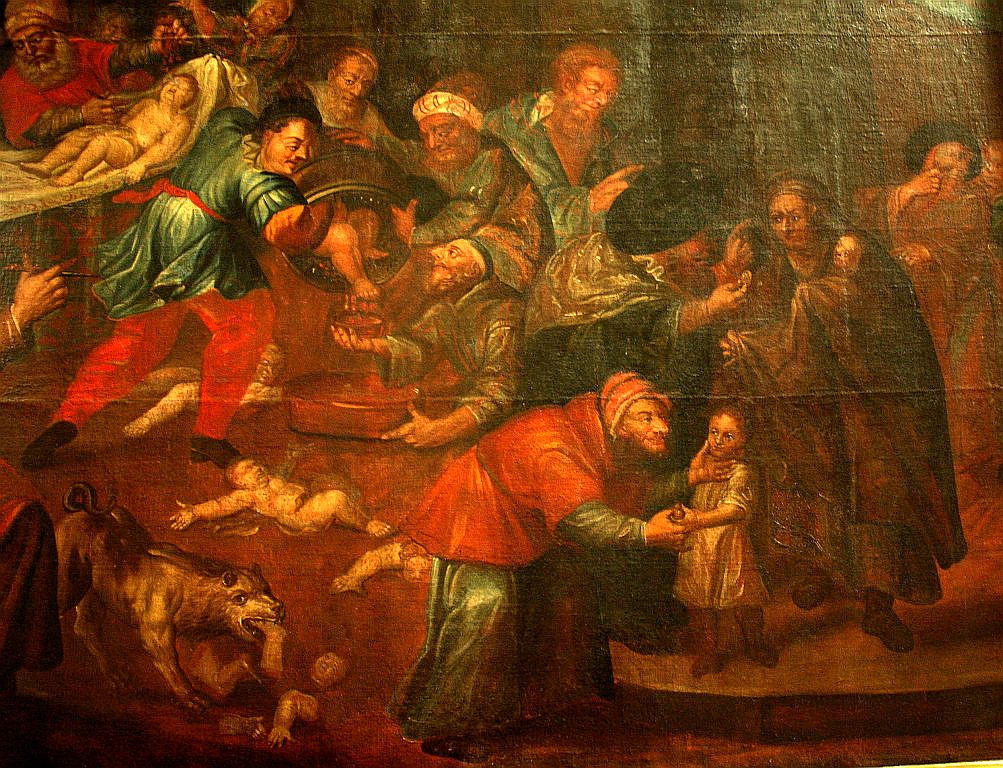|
Antijudaism
Anti-Judaism is the "total or partial opposition to Judaism as a religion—and the total or partial opposition to Jews as adherents of it—by persons who accept a competing system of beliefs and practices and consider certain genuine Judaic beliefs and practices inferior." According to Douglas Hare, there are three types of Anti-Judaism: (1) Prophetic Anti-judaism - the criticism of the beliefs and religious practices of the religion; (2) Jewish-Christian anti-Judaism - Jews who believe that Jesus is the Messiah; and (3) Gentilizing anti-Judaism - emphasis on the gentile character of the new movement and claiming god's rejection of the "old" Israel. Anti-Judaism, as a rejection of a particular way of thinking about God, is distinct from antisemitism, which is more akin to a form of racism. Scholars wishing to blur the line between theology and racism have since coined the term religious antisemitism. Both the Christian doctrine of supersessionism and the Islamic doctrine ... [...More Info...] [...Related Items...] OR: [Wikipedia] [Google] [Baidu] |
Religious Antisemitism
Religious antisemitism is aversion to or discrimination against Jews as a whole, based on religious doctrines of supersession that expect or demand the disappearance of Judaism and the conversion of Jews, and which figure their political enemies in Jewish terms. This often has led to false claims against Judaism and religious antisemitic canards. It is sometimes called theological antisemitism. Some scholars have argued that modern antisemitism is primarily based on nonreligious factors, John Higham being emblematic of this school of thought. However, this interpretation has been challenged. In 1966 Charles Glock and Rodney Stark first published public option polling data showing that most Americans based their stereotypes of Jews on religion. Further opinion polling since in America and Europe has supported this conclusion. Origins Father Edward Flannery, in his ''The Anguish of the Jew: Twenty-Three Centuries of Antisemitism'', traces the first clear examples of specific ... [...More Info...] [...Related Items...] OR: [Wikipedia] [Google] [Baidu] |
Judaism
Judaism ( he, ''Yahăḏūṯ'') is an Abrahamic, monotheistic, and ethnic religion comprising the collective religious, cultural, and legal tradition and civilization of the Jewish people. It has its roots as an organized religion in the Middle East during the Bronze Age. Modern Judaism evolved from Yahwism, the religion of ancient Israel and Judah, by the late 6th century BCE, and is thus considered to be one of the oldest monotheistic religions. Judaism is considered by religious Jews to be the expression of the covenant that God established with the Israelites, their ancestors. It encompasses a wide body of texts, practices, theological positions, and forms of organization. The Torah, as it is commonly understood by Jews, is part of the larger text known as the ''Tanakh''. The ''Tanakh'' is also known to secular scholars of religion as the Hebrew Bible, and to Christians as the " Old Testament". The Torah's supplemental oral tradition is represented by later texts s ... [...More Info...] [...Related Items...] OR: [Wikipedia] [Google] [Baidu] |
Shofar (journal)
''Shofar: An Interdisciplinary Journal of Jewish Studies'' is a triannual peer-reviewed academic journal published by Purdue University Press on behalf of the university's Jewish Studies Program. ''Shofar'' is the official journal of the Midwest and Western Jewish Studies Associations. The journal publishes original, scholarly work and reviews a wide range of recent books in Judaica. History The journal was originally established as a departmental newsletter by Joseph Haberer in 1981. Over time, it developed into a peer-reviewed journal. See also * ''Journal of Jewish Studies A journal, from the Old French ''journal'' (meaning "daily"), may refer to: *Bullet journal, a method of personal organization *Diary, a record of what happened over the course of a day or other period *Daybook, also known as a general journal, a ...'' References External links * ''Shofar''on the Purdue University Jewish Studies Program website Judaic studies journals Publications establishe ... [...More Info...] [...Related Items...] OR: [Wikipedia] [Google] [Baidu] |
Census Of Quirinius
The Census of Quirinius is generally believed to be a census of Judea taken by Publius Sulpicius Quirinius, governor of Roman Syria, upon the imposition of direct Roman rule in 6 CE. The Gospel of Luke uses it to date the birth of Jesus, which the Gospel of Matthew places in the time of Herod the Great (who died between 5 BCE and 1 CE). Luke appears to have conflated Quirinius's census with the death of Herod, and most critical scholars acknowledge a confusion and misdating by Luke. Overview Herod I (Herod the Great, ), was a Roman client king whose territory included Judea. Upon his death, his kingdom was divided into three, each section ruled by one of his sons. In 6 CE, Emperor Augustus deposed Herod Archelaus, who had ruled the largest section, and converted his territory into the Roman province of Judea. Publius Sulpicius Quirinius, the legate (governor) of the province of Roman Syria starting in 6 CE, was assigned to carry out a census of the n ... [...More Info...] [...Related Items...] OR: [Wikipedia] [Google] [Baidu] |
Caligula
Gaius Julius Caesar Augustus Germanicus (31 August 12 – 24 January 41), better known by his nickname Caligula (), was the third Roman emperor, ruling from 37 until his assassination in 41. He was the son of the popular Roman general Germanicus and Augustus' granddaughter Agrippina the Elder. Caligula was born into the first ruling family of the Roman Empire, conventionally known as the Julio-Claudian dynasty. Although Gaius was named after Julius Caesar, Gaius Julius Caesar, he acquired the nickname "Caligula" ("little ''caligae, caliga''," a type of military boot) from his father's soldiers during their campaign in Germania. When Germanicus died at Antioch in 19, Agrippina returned with her six children to Rome, where she became entangled in a bitter feud with Tiberius. The conflict eventually led to the destruction of her family, with Caligula as the sole male survivor. In 26, Tiberius withdrew from public life to the island of Capri, and in 31, Caligula joined him there. Fo ... [...More Info...] [...Related Items...] OR: [Wikipedia] [Google] [Baidu] |
Hyrcanus II
John Hyrcanus II (, ''Yohanan Hurqanos'') (died 30 BCE), a member of the Hasmonean dynasty, was for a long time the Jewish High Priest in the 1st century BCE. He was also briefly King of Judea 67–66 BCE and then the ethnarch (ruler) of Judea, probably over the period 47–40 BCE. Accession Hyrcanus was the eldest son of Alexander Jannaeus, King and High Priest, and Alexandra Salome. After the death of Alexander in 76 BCE, his widow succeeded to the rule of Judea and installed her elder son Hyrcanus as High Priest. Alexander had numerous conflicts with the Pharisees. However Hyrcanus was supported by the Pharisees, especially later in his tenure. When Salome died in 67 BCE, she named Hyrcanus as her successor as ruler of Judea as well, but soon he and his younger brother, Aristobulus II, dissented over the right to the throne. Deposition Hyrcanus had scarcely reigned three months when Aristobulus II rose in rebellion. Hyrcanus advanced against him at the head of hi ... [...More Info...] [...Related Items...] OR: [Wikipedia] [Google] [Baidu] |
Patronage In Ancient Rome
Patronage is the support, encouragement, privilege, or financial aid that an organization or individual bestows on another. In the history of art, arts patronage refers to the support that kings, popes, and the wealthy have provided to artists such as musicians, painters, and sculptors. It can also refer to the right of bestowing offices or church benefices, the business given to a store by a regular customer, and the guardianship of saints. The word "patron" derives from the la, patronus ("patron"), one who gives benefits to his clients (see Patronage in ancient Rome). In some countries the term is used to describe political patronage or patronal politics, which is the use of state resources to reward individuals for their electoral support. Some patronage systems are legal, as in the Canadian tradition of the Prime Minister to appoint senators and the heads of a number of commissions and agencies; in many cases, these appointments go to people who have supported the politica ... [...More Info...] [...Related Items...] OR: [Wikipedia] [Google] [Baidu] |
Holy Of Holies
The Holy of Holies (Hebrew: ''Qōḏeš haqQŏḏāšīm'' or ''Kodesh HaKodashim''; also הַדְּבִיר ''haDəḇīr'', 'the Sanctuary') is a term in the Hebrew Bible that refers to the inner sanctuary of the Tabernacle, where God's presence appeared. According to Hebrew tradition, the area was defined by four pillars that held up the veil of the covering, under which the Ark of the Covenant was held above the floor. According to the Hebrew scripture, the Ark contained the Ten Commandments, which were given by God to Moses on Mount Sinai. The Temple in Jerusalem was said to have been built by King Solomon for keeping the Ark. Ancient Jewish traditions viewed the Holy of Holies as the spiritual junction of Heaven and Earth, the "axis mundi". As a part of the Jewish Temple in Jerusalem, the Holy of Holies was situated somewhere on Temple Mount; its precise location in the Mount being a matter of dispute, with some classical Jewish sources identifying its location with the ... [...More Info...] [...Related Items...] OR: [Wikipedia] [Google] [Baidu] |




_(31023042187)_CROP.jpg)
